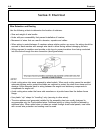
2-12 Electrical
Section 2: Electrical
Wire Retention and Routing
Use the following criteria to determine the location of retainers:
• Size and weight of wire bundle.
• Holes with poor accessibility that prevent installation of locators.
• Movement of wires that can result in abrasion, squeaks and rattles.
• When wiring is routed between 2 members where relative motion can occur, the wiring should be
secured to each member with enough wire slack to allow flexing without damaging the wire.
• Wiring exposed to weather must provide a drip loop to prevent moisture from being conducted
into the device through the wire connection (see figure below).
• Avoid routing wires into areas exposed to wheel splash. When such routing cannot be avoided,
adequate clipping and/or protective shields are required to protect the wires from stone and ice
damage. Allow adequate slack in wiring between the engine and stationary components to
compensate for engine roll.
• Avoid routing wires under the frame side members or at points lower than the bottom frame
flange.
• Use plastic ‘‘zip’’ straps for ‘‘bundling’’ only (securing to other wires).
• The wire retainers and grommets installed by the assembly plant are usually designed to
accommodate only the Ford-installed wires. Additional wiring or tubing should be retained by
additional clips. When added wires or tubes are routed through sheet metal panels, new holes
with correct wire protection and sealing must be used.
2010 Expedition SSV Modifiers Guide, 07/2009


















